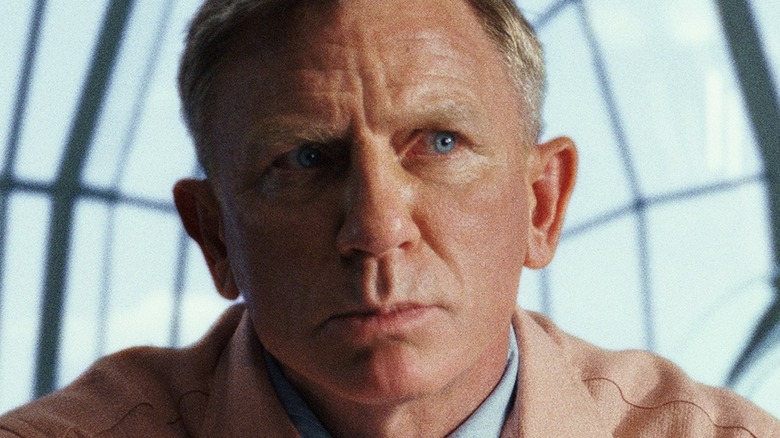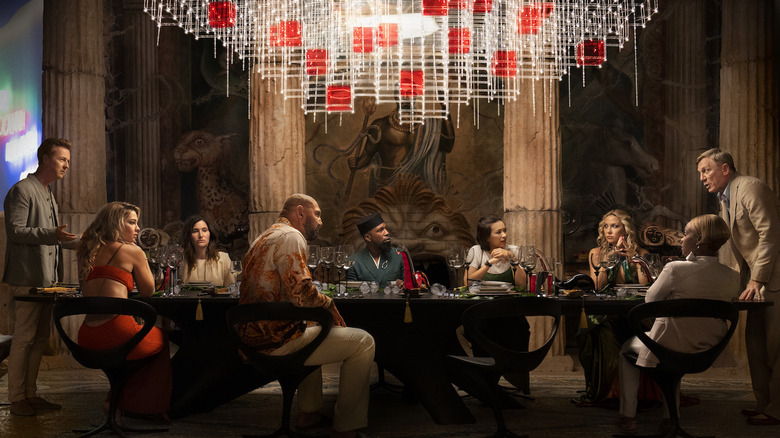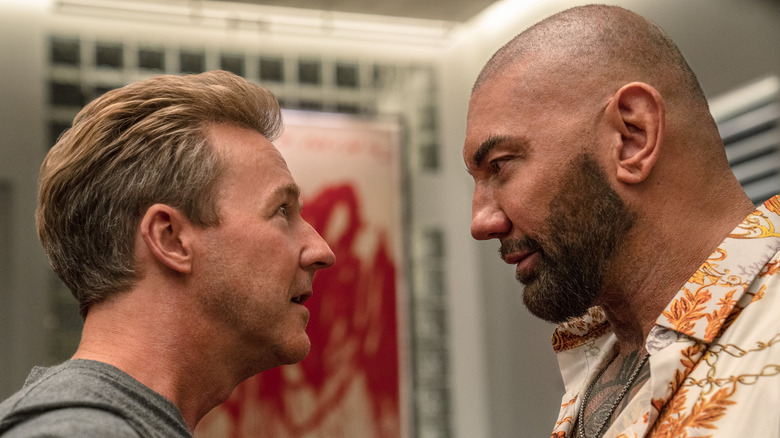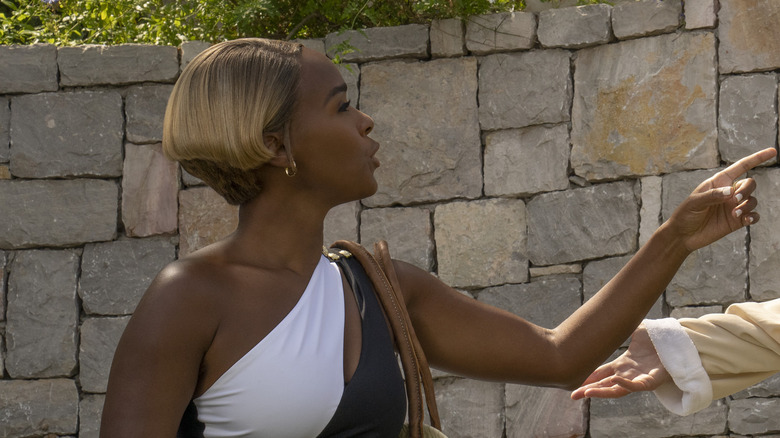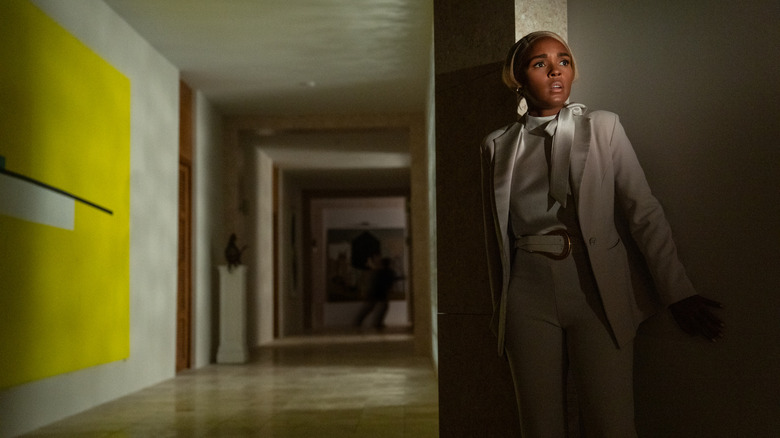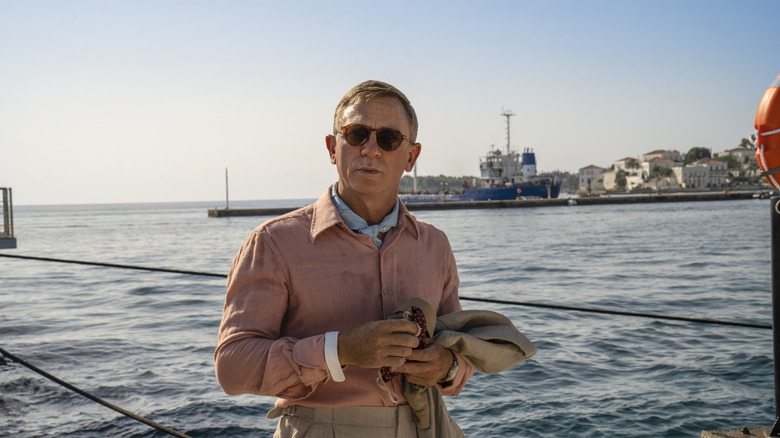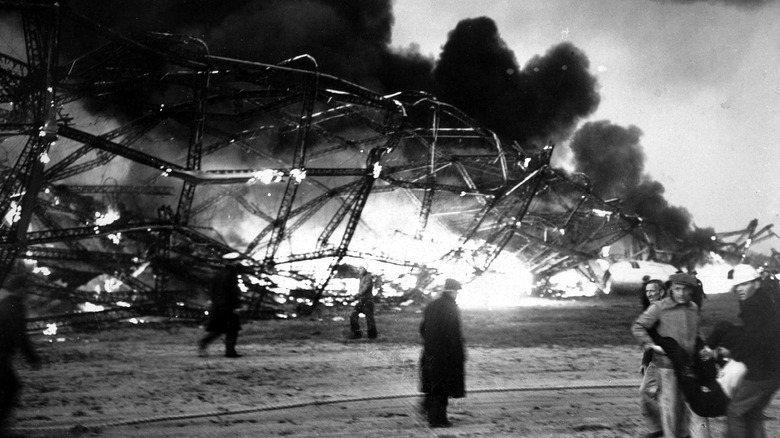The Ending Of Glass Onion: A Knives Out Mystery Explained
WARNING: The following contains spoilers for "Glass Onion: A Knives Out Mystery."
The title "Glass Onion" means a few different things. It's a reference to a Beatles song (similar to how its predecessor, "Knives Out," was named for a Radiohead song), and within the movie, it's the name of the Grecian island estate of billionaire Miles Bron (Edward Norton), the literal glass onion-shaped building at the center of the estate, and the bar at which Miles and his friends were first introduced to each other. Yet this title also has another meaning that's central to understanding the mysteries at the center of the film: an onion has layers, but a "glass onion" is clear and empty, despite taking the shape of something layered and complex.
Thus begins the trickery in the narrative of "Glass Onion: A Knives Out Mystery": it's made to look like a confusing case with many possible suspects and motives for murder, but in the end, it all comes down to the simplest possible explanation. It's a similar trick to what the first "Knives Out" movie pulled, but whereas that movie tricked viewers via making one man's murder appear as if it was another woman's accident, the sequel "Glass Onion" does so by disguising who the actual real and intended victims of its multiple crimes are. This article will break down how the mystery in "Glass Onion" plays out, and the consequences that emerge from its series of big reveals and twists.
The big misdirect
The trick at the center of "Glass Onion" is making the viewer believe somebody is trying to murder Miles Bron. Miles invites his old friends and business partners to his island for a vacation getaway in which they will try to solve his pretend "murder" as part of an elaborate mystery game. Those invited include political candidate Claire Debella (Kathryn Hahn), tech nerd Lionel Toussaint (Leslie Odom Jr.), Joe Rogan-esque streamer Duke Cody (Dave Bautista), "canceled" fashion designer Birdie Jay (Kate Hudson), his estranged former business partner Cassandra "Andi" Brand (Janelle Monáe)... and detective Benoit Blanc (Daniel Craig), who was invited by someone, not Miles.
Benoit solves the fake murder mystery game before it even officially begins (it was Birdie, apparently). Miles is annoyed that his whole plan has been wasted (he hired "Gone Girl" author Gillian Flynn to plan out the game for him), but Benoit warns him that it seems risky to be doing this game in the first place — because it could plant the idea of murdering Miles into the minds of people who could benefit from murdering him. In this way, the audience is set up to observe the various ways Miles' guests feel wronged by their host: Andi had a serious falling out with Miles long ago, Claire and Lionel fear his new solid hydrogen-based power source Klear is too risky, Birdie is being set up to take all the blame for mistakes in her business venture with Miles, and Duke notices that Miles has been sleeping with his girlfriend Whiskey (Madelyn Cline).
Duke Cody's murder explained
The issue of suspecting others wanting to kill Miles comes to a head when Duke collapses and dies after drinking from Miles' glass. This makes it look like Duke was the unintended victim of an attempt on Miles' life, which initially appears to be the big murder mystery at the center of the film. Another murder, however, overtakes it as the center of the story, and when Benoit comes back around to explaining Duke's death, it's all tied in with the other cases.
The actual explanation for Duke's death is very different from what it initially looks like to everyone else: Miles isn't the intended victim, but is, in fact, the killer! While everyone is too busy watching Birdie dance, Miles hands Duke his glass intentionally, and Miles' lies distort everyone's memories after the fact. It isn't poison in the drink that killed Duke, but rather pineapple juice, to which Duke is deathly allergic.
Duke is also a useful pawn in Miles' game for getting away with the other murder he committed. Miles refuses to use any communications technology beyond his beloved fax machines, but Duke is constantly getting news notifications on his phone. It's through Duke's constant news notifications that Miles finds out when Andi's death has been reported by the news, and to prevent anyone else from finding out about the news, Miles decides to kill Duke and steal both his phone and his gun.
Andi's murder, explained
While everyone is panicking about Duke's death, all the lights in the mansion suddenly go dark. Miles claims this is something that was planned as part of the original murder mystery game, and that now happens to have some really unfortunate timing. In actuality, it's quite fortunate for Miles, who didn't originally plan for the lights going out but instead stole the idea from Benoit Blanc, who tried to warn him that inviting people who hate him and theoretically have reason to kill him to a murder mystery party was akin to "a loaded gun in the dark."
In the dark, Miles is able to follow through on Benoit's metaphor and gets away with grabbing a loaded gun in the dark, shooting Andi through glass. When everyone finds each other outside, it looks as if Andi is bleeding to death. Andi, however, isn't actually dead; a journal was in her chest pocket and blocked the bullet from hitting her. Benoit subsequently helped her fake playing dead with a bottle of Jeremy Renner's hot sauce to use for fake blood. Then, in an extended flashback sequence — after we see the shooting but before we learn about the hot sauce and Miles' guilt in the attempted murder — we also learn that the "Andi" attending this party isn't actually the real Andi.
The real Andi's real murder, explained
So Janelle Monáe's much-hyped performance in "Glass Onion" is actually two different characters: there's Andi, the brilliant businesswoman whose company was stolen by Miles, and then there's her identical twin sister Helen, a schoolteacher who's been on the island in disguise as Andi the whole time.
The real Andi was responsible for introducing Miles to his future friends at the original Glass Onion bar back in the day, and it was on one of that bar's napkins that she sketched out the plan for the tech empire that would make Miles famous. Miles wasn't particularly intelligent himself, but he was rich, and could pay smarter, more talented people to do his work for him. Eventually, Miles' self-built myth went to the extreme, and he started denying Andi's founding role in his business, plagiarizing the napkin to claim he wrote it and paying off the rest of his friend group to echo his claims and perjure themselves in court on his behalf.
Before she died, Andi sent out an email with a picture of herself holding a red envelope, threatening to use the envelope's contents to destroy Miles' career. Miles does not use email, but Lionel faxed it to him. The killer, of course, was Miles, who received her email (via a fax from Lionel) while quietly in New York seeing Whiskey. From there, he headed upstate to see Andi, poisoned her drink, and stole the envelope — and almost "pancakes" Duke with his very noticeable car as he leaves the scene of the crime and Duke arrives to check on Andi.
The investigation was happening from the start
After finding Andi's invitation to the party but before actually going, Helen hires Benoit to investigate Andi's suspicious death. Though the cops assume otherwise, Helen reasonably suspects foul play. Benoit has enough connections in the media to keep the news of Andi's death temporarily under wraps, so nobody at the party except for Helen, Benoit, and Andi's killer know that she's dead. As such, Benoit hatched a perfect plan for investigating the Andi's probable murder: have Helen impersonate her late sister at the party.
After fake Andi/Helen gets shot, "Glass Onion" flashes back in time to Helen hiring Blanc and proceeds to repeat the events of the first section of the movie from Helen's perspective. For each of the partygoers, she listens in on conversations to try to identify both specific motives and potential opportunities for them to have committed the murder ("like Clue," she says to Benoit's constant chagrin). It turns out everyone had paid a visit to Andi's house the day of the murder, and everyone had something to gain from killing her. The possibilities seem numerous, the layers of this "onion" of a case seemingly overwhelming.
Of course, the onion is a glass one, and the solution is simpler than expected. Helen suspected Miles of being the killer from the start, a theory Benoit dismissed due to thinking Miles too smart for that. Once Benoit realizes Miles is not actually intelligent, however, everything comes into focus.
Solving the case by finding the envelope
Benoit's big Columbo-esque monologue at the climax of the film in which he explains how he's figured out Miles' guilt in both Andi and Duke's murders is based on a combination of character assessments (Miles not actually being a smart person), overlooked visual details (Miles passing Duke the drink), and things previously spoken about by the various partygoers (Duke's pineapple allergy, Miles being spotted in New York around the time of Andi's death). What it needs to come together definitively is a piece of evidence, which Helen is able to retrieve from the center of the Glass Onion while everyone else thinks she's dead.
Miles' motive for killing Andi was to steal and hide the red envelope containing her career-ending blackmail on him, so all Helen needs to do is to find the envelope. Before she got shot during the blackout, Helen went through everyone's rooms to try and find the envelope. The last room she checks, after she's been presumed dead by the other guests, is Miles' own. It turns out he had hidden the envelope in plain sight: it was the red background seen within the picture frame that holds Miles' forged napkin diagram. It's both a logical and a stupid hiding place to put the envelope that happens to contain Andi's actual napkin diagram (which, unliked the forged one, was written on a napkin clearly labeled with the insignia for the Glass Onion bar).
Why Benoit Blanc can't bring Miles Bron to justice
From the beginning of the movie, Benoit Blanc makes it repeatedly clear that he's "not Batman" — he's a detective who works within the legal system and is not one to dish out any sort of vigilante justice himself. He can find and present the truth of what happened, but he lets the cops and the courts do what they need to actually enact any punishments for the crimes he investigates. Unfortunately, the single piece of physical evidence holding this case together is one that's all too easy to destroy.
Before the police boats can even come close to the island, Miles burns up Andi's original napkin, effectively destroying the chances of this case ever holding up in court. Miles once again tries to control the narrative through lies, and his friends still aren't brave enough to truly stand up to him. Benoit is clear that there's nothing he can do. His last actions before exiting the Glass Onion mansion are to offer Helen a few words of inspiration to give her the strength to do what she determines is necessary, and to hand her two objects: another drink (not the Jared Leto hard kombucha she's been drinking for the rest of the movie) and a sample of Klear to remind her just what her sister was trying to stop.
The Glass Onion goes Hindenburg
Ultimately, the authorities are unlikely to able to do anything about Miles killing two of his friends — you know, one of whom he stole an entire company from and another he attempted to kill. Fortunately, Helen is now just drunk and inspired enough to start taking matters into her own hands. The Glass Onion is filled with tacky glass sculptures and glass furniture, so it's an easy act of protest for Helen to just start wrecking the place after Benoit takes his leave. The other guests, feeling guilty about their connections with Miles and betrayal of Andi, cautiously join in on the destruction.
Helen finishes off the property damage by definitively disproving Miles' claims that his poorly conceived solid hydrogen fuel source Klear is safe. Andi feared putting the untested power source on the market would lead to new equivalents of the Hindenburg explosion. Helen puts the theory into practice by destroying a table covered in alcoholic drinks, lighting it on fire, and then throwing the sample Klear fuel crystal Benoit handed her into the burning wreckage, causing a chemical reaction that leads to the room going up in flames and the Glass Onion itself exploding. All the people inside avoid getting hurt and manage to escape, but one particular prized possession of Miles is officially cooked.
In the same sentence as the Mona Lisa
Miles' most ostentatious showcase of wealth and power throughout the film is displaying the original Mona Lisa by Leonardo da Vinci inside a sound-activated security chamber in the Glass Onion, taking it out from the Louvre on loan while the museum was closed due to the COVID-19 pandemic. Ten years beforehand, when Andi first introduced Miles to the rest of her friends, Miles announced his goal was to "make something that would be mentioned in the same sentence as the Mona Lisa" — a pretentious turn of phrasing that confuses almost everyone who hears it but basically means he wants some form of an immortal legacy. Now, thanks to Helen, his wish is granted, but not for the reasons he was hoping for.
When Helen makes the Glass Onion "go Hindenburg," all she has to do is hit the override button on the glass case protecting the Mona Lisa for the beloved painting to burn to a crisp. This grants Miles his wish in a truly ironic sense: his fuel will be mentioned alongside the Mona Lisa, but not for any positive reasons. It also challenges what Miles meant with by saying that: he was using the Mona Lisa as an example of something that would be around forever long past his death, but now the legendary painting has turned into yet another reminder of how everything is impermanent. Miles was obsessed with legacy, and now his legacy is sure to be a complete disaster even if the murders themselves aren't found out about.
The one completely irrelevant character
As a carefully constructed mystery thriller, "Glass Onion" is filled with "Chekhov's guns" — details introduced early on in the movie that pay off as relevant to the narrative later on. Benoit Blanc's wild genius is that he notices everything around him and is able to place everything together into a cohesive story. But as much as "Glass Onion" is a satisfying example of its genre, it's also a comedy poking light fun at it, and one example of how it does so is by introducing a character with absolutely no relevance to the mystery whatsoever: Derol.
Played by Noah Segan — who also played the character of Trooper Wagner in the first "Knives Out" and has made appearances in all of Rian Johnson's films — Derol is both a red herring and additional comic relief. He's a stoner guest who smells like Jared Leto kombucha just hanging out at the Glass Onion, but he's not part of the party and has no connection to the murders that take place there. Whenever he crosses paths with the party guests, it creates a sense of comedic awkwardness, particularly when Helen breaks into his room while searching for the red envelope. At the end of the movie, he and Benoit share a lighter while sitting outside and watching the fireworks of the Glass Onion exploding.
